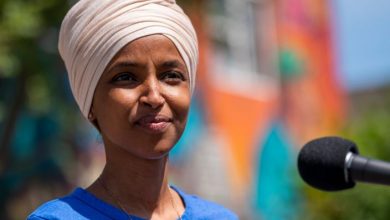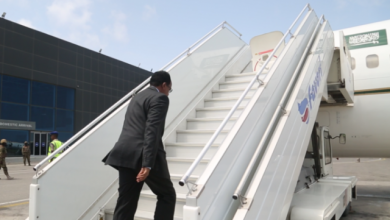‘Somalinimo’: Meet the Somali women of Cambridge University
Earlier this week, Somalinimo was trending on Twitter. Awa Farah, Cambridge University student and filmmaker, explains the term in her own words: “Somalinimo means ‘somaliness’, the essence of what it means to be Somali”, and it is also the title of her new documentary, made in collaboration with filmmaker Alice Aedy, which was released this week by the Guardian.
Earlier this week, Somalinimo was trending on Twitter. Awa Farah, Cambridge University student and filmmaker, explains the term in her own words: “Somalinimo means ‘somaliness’, the essence of what it means to be Somali”, and it is also the title of her new documentary, made in collaboration with filmmaker Alice Aedy, which was released this week by the Guardian.
It centres around the life stories of three Cambridge University students, and one applicant: Documentary-maker Awa, Miske, Hafsa and Samiya. They are also British Somali women. They talk about their background, family and culture, and how that affected their experience of applying to, and being at Cambridge. The documentary tackles the complexities of being a Black, Muslim woman at an institution historically inaccessible to those of their background. Although Cambridge, along with other higher education institutions, regularly hits the headlines for poor access admissions statistics, Awa and Alice explore the lived experiences of those in the film, celebrating Somali culture and putting it side by side with the Cambridge student life.
The Cambridge Tab spoke to Awa and Alice about their latest documentary, how they wanted to portray Cambridge and Somalia, its reception, and how their work fits into the wider picture of access and identity in higher education institutions in the UK.
“We wanted to create a film that told a story about young Black Muslim women as those stories are rarely told.”
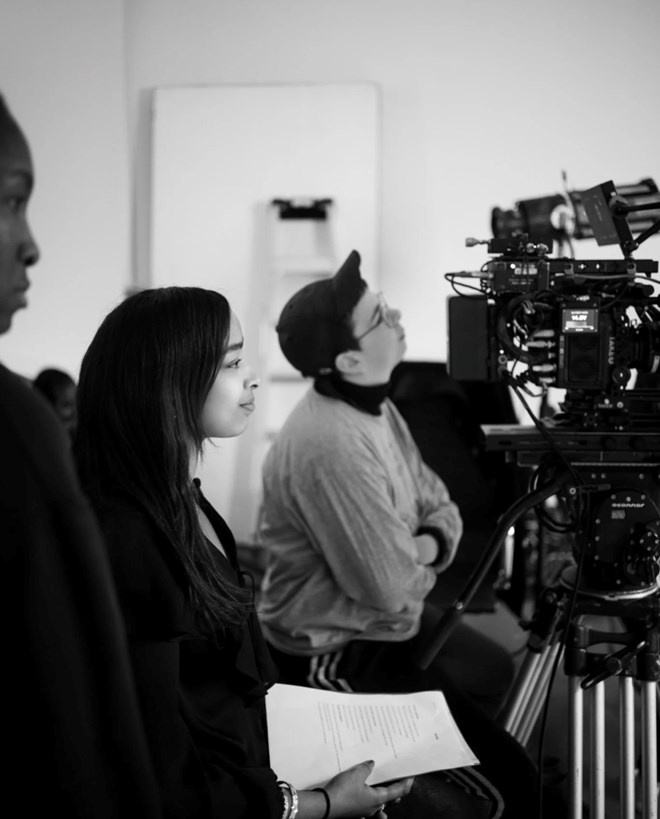
Awa Farah, this time behind the scenes (credit: Alice Aedy)
Awa, who completed her second Masters’ degree at Wolfson College and has just begun a PhD in sociology at Churchill, started thinking about creating Somalinimo in 2018. She says: “I was researching the Somali diaspora in the UK. I was becoming increasingly tired of the monolithic stereotypical depiction both in literature and film.
“I came across Alice’s photography work on Somali women and found it beautifully refreshing. Upon meeting, we instantly knew we wanted to create a film that told a story about young Black Muslim women as those stories are rarely told.”
Alice confirmed that they formed a connection instantly: “From the moment I met her, I knew this would be an important collaboration. Awa told me about her time at Cambridge studying an MPhil in African studies, a place that was not made for people “like her”, but where she carved out a powerful sense of home through the Somali women she met there.”
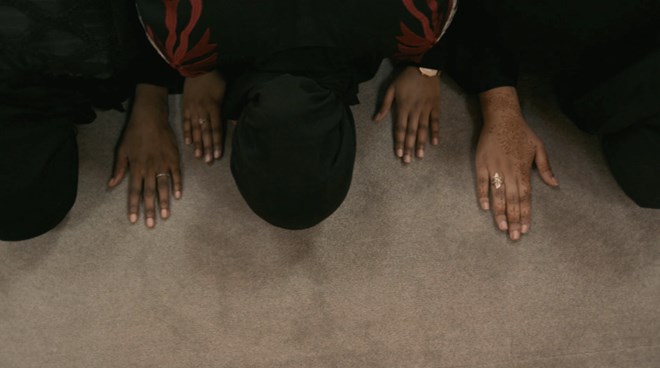
Alice: “We hoped to make a film that unapologetically showcases love for Somalia’s colourful traditions and traditional dress, blackness and Islam.” (Still from Somalinimo)
She continued: “We hoped to make a visually cinematic short film exploring what it means to live with the triple consciousness of being part of three marginalised groups: black, female and Muslim, at one of the UK’s most traditional institutions, Cambridge University.”
“We began thinking about how we could visually merge these two worlds”
The documentary has a huge visual impact. Sets include areas of Cambridge University (more specifically Pembroke and Wolfson Colleges) as well as scenes from Cambridge city centre. However, the film has a far wider scope, also taking the viewer through the multi-cultural area of North London, a Somali living room, as well as certain shots of Somalia itself. Place and sense of place are of great significance in the documentary, as Alice explains:
“Awa spoke powerfully about the way the physical spaces of Cambridge made her feel. It became important to represent those spaces visually; the spaces that could make the women feel isolated, like the dining hall; empowered, like the mosque; a sense of home, like the Somali living room set design. We worked with an incredibly talented cinematographer, Molly Manning-Walker, to represent how each space evoked emotion.”
One especially memorable part of the short film is an image of the current Cambridge students silhouetted against Pembroke cloisters in traditional Somali dress. Alice says: “Awa and I wanted all four women to walk through Cambridge in their ‘diraacs’ – traditional Somali dress – as a powerful celebration of their Somali heritage.”
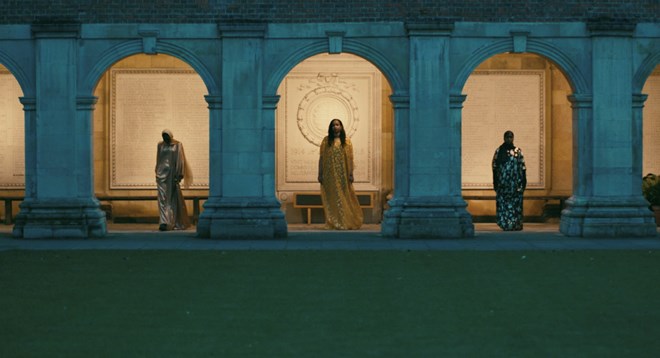
Comparing and contrasting Somali culture and the Cambridge experience (Still from Somalinimo)
“Conveying the richness and colour of Somali culture was just as important as the ‘Cambridge’ aspect”, Awa continues. “We began thinking about how we could visually merge these two worlds with clothing, set design, architecture, and music, and it all just fell together quite naturally.”
One of Awa’s favourite sets, though, is not of Cambridge itself, but the traditional Somali living room. She enthused: “I absolutely love the Somali living room scenes. A lot of love went into recreating that set, and sitting there with all the girls having a conversation felt like home.”
Alice describes the set and its value in the film: “We built the set design of a traditional Somali home to evoke a powerful sense of nostalgia, and of Somalia (the way the girls’ parents might have spoken about it.) The Somali living room visually depicted a sense of belonging – a comfort zone – in contrast to the spaces in Cambridge which could sometimes be isolating.”
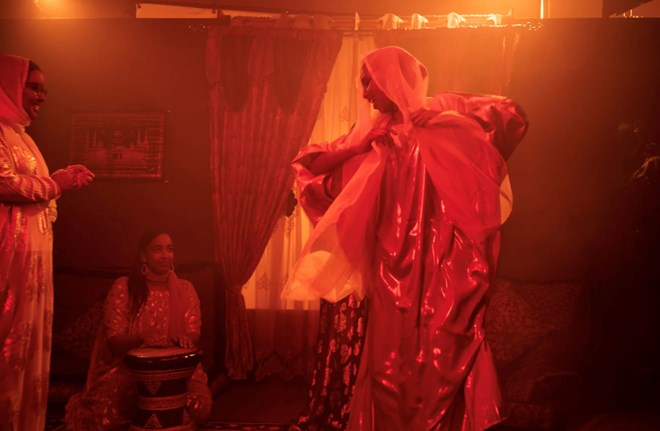
The traditional Somali living room set (Still from Somalinimo)
“When you are black and Muslim, you don’t get the option of not being confronted by your identity. It’s very visible.”
The four students who star in the documentary have a connection which reaches out beyond the screen. They freely discuss the complex and often very personal themes of identity and fitting in eloquently and with real warmth, something which Awa attributes to having already discussed these topics together outside of the documentary.
In chapter seven of the documentary, entitled ‘Visibility’, Awa describes the rapid adjustment from living in a multicultural area of North London, to a mainly white Cambridge, alongside images of the people of North London and Cambridge who attest to this radically different ethnic makeup. Alongside the more practical issues such as loss of easy access to halal food, being Somali in Cambridge meant that blending in in a way that was possible in London was not an option in Cambridge. Of this Awa said: “In many ways, the conversations we were having on screen were just an extension of those we had at Cambridge as students. I think when you are black and Muslim, you don’t get the option of not being confronted by your identity. It’s very visible.”
Alice was greatly inspired by the girls and how their personalities came across on screen. “The four protagonists of Somalinimo are incredibly articulate about identity, their humour is disarming, and their experiences are unique. We wanted the film to offer a platform for them to tell their stories, in their own words, straight down the lens.”
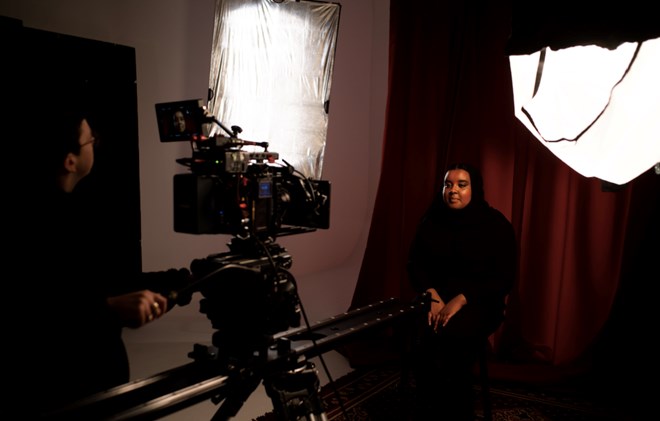
Behind the scenes shot, in discussion with Samiya (credit: Awa Farah)
She continues: “Whilst Somalinimo explores the journey of Somali women studying at the University of Cambridge, questioning belonging and Britishness, it is ultimately a story of finding strong ties to their Somali roots. I think that is incredibly profound, and something to be celebrated.”
Despite finding it difficult at times to reconcile her identity with a place like Cambridge University, Awa asserts that finding other students from a similar background (however rare that may be) was a key part of her life there. She said: “ultimately finding these communities where I could be myself entirely was what made my time at Cambridge so much richer.”
“I want this film to inspire young women. You can’t be what you can’t see.”
The documentary has been a real hit since its release. Awa describes her joy at its reception on social media: “The response has been overwhelming! Receiving messages from people from all backgrounds, saying that they resonate with the story, has been incredibly heart-warming.” The theme of Somali roots and family runs through the documentary, and when asked if her family had had a chance to watch it, she responded: “I showed my family the finished piece before it was released, and they loved it!”
The desired outcome of the documentary though, from both Alice and Awa, is more than mentions on Twitter or video views. Alice explains that she hopes that her work puts a spotlight on a community often left out of the conversation in mainstream media: “For a long time, Somali communities have been underestimated and underrepresented in the film industry. Somalinimo‘s overarching theme of identity and home represents a new generation of Somalis in film.”
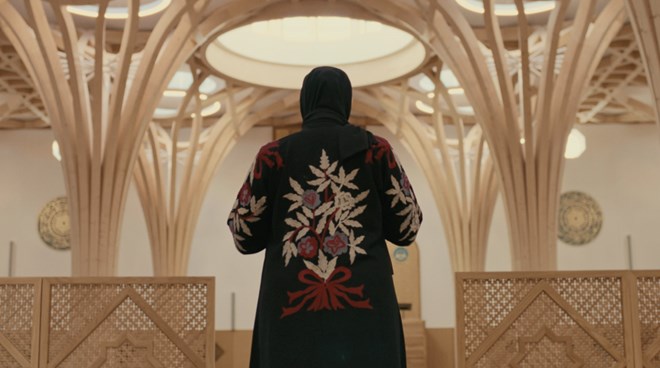
One of many scenes of prayer (Still from Somalinimo)
Creating a visual space and giving voice to a less visible group in media, she hopes, will lead the way for young Somali women to follow in the footsteps of the students featured. “I want this film to inspire young women. You can’t be what you can’t see. This is a film we want young women to watch. We want them to recognise themselves in Awa, Samiya, Hafsa and Miske, powerful women creating a legacy for future generations.”
More specifically, by featuring Black, Muslim women who have taken up places at Cambridge University, Awa hopes to inspire younger girls from a similar background to aspire to Oxbridge, when perhaps they might not have felt it was possible for them. “I hope that young black, Muslim students from state schools thinking of applying to Oxbridge can watch this film and feel that despite all the barriers, you still have every right to make it your home and bring yourself fully.”
“We must tell positive stories that celebrate Black talent and experience.”
The film’s release coincides with what has been described as a watershed moment in global history. Amidst a summer of protests and challenging systemic racism following the death of George Floyd in the US and renewed scrutiny of institutions and their treatment of the Black community on both sides of the Atlantic, Alice and Awa reflect on the revelations of their own work and their hopes for the future.
Alice speaks of the role of media and documentaries like Somalinimo in this changing world: “Since we made Somalinimo, the world has changed beyond recognition. The extraordinary Black Lives Matter movement has served as a poignant reminder of how far we have to go in the fight for equal representation and treatment of Black people in Britain. As storytellers we must play a role in challenging dominant narratives and stereotypes. We must tell positive stories that celebrate Black talent and experience.
“It’s no secret that elite universities, including Cambridge University, have extremely poor diversity records.” she continues, “The Black Lives Matter movement only served to highlight this urgent issue. I have been inspired by groups like The Black Curriculum, an initiative teaching Black history to 8-16 year olds, and other important campaigns to decolonise the British curriculum at schools and universities across the country.”
Awa points to the positive changes which have already been effected: “there has been a massive drive to get more black students and those from state schools into elite institutions such as Cambridge, which is great! But getting students through the door will not be enough on its own.
“Segments of the film address the explicit and implicit ways Cambridge can feel alienating to black students even beyond the admission stage. Universities need to engage with the systematic and structural nature of racism for students from all background to thrive once they enter elite, predominantly white spaces.”
Alice summarises the two sides of her and Awa’s documentary: “I never set out to make an indictment of Cambridge University, rather a celebration of these four women. However, I do want the audience to finish watching the film with a profound sense that every university is doing itself – and its students – a disservice by having such poor diversity records.” In the final moments of the documentary appears a shocking statistic: “Out of 12,163 Undergraduate students approx. 200 are from a Black African Caribbean background” according to Cambridge undergraduate admission statistics.
Ultimately, though, this documentary is a heartwarming story of four students who tell of their lives and upbringings which led them to study at Cambridge, and how they navigated life at the University, realising their dream to get there.“During filming, we laughed a lot, cried some, shared frustration, and ultimately felt inspired and hopeful.” Awa says, “If the viewers feel a sense of that, I think it’s done its job.”
The short film opens on an old Somali proverb, which means in translation: “Either be visible or be absent”. The visibility that Awa and Alice have given to the Somali women of Cambridge is both fascinating and engaging to watch, providing a unique access point simultaneously into Somali culture and Cambridge University life that has never before been put across on screen.
If you still haven’t watched the documentary, you can watch it here.
Feature image credit: Alice Aedy, documentary still from Somalinimo

